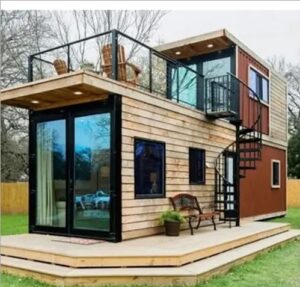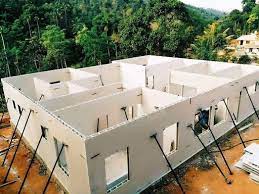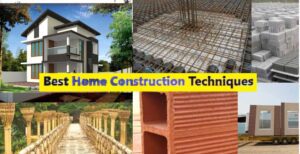How to Construct the Best Home?
- The best home construction techniques in India depend on various factors such as the region, climate, budget, and personal preferences.
- However, here are some general considerations and techniques that are often recommended for home construction in India:
Climate Considerations:
- Hot and Humid Regions: In areas with a hot and humid climate, proper insulation and ventilation are crucial.
- Consider using materials that can withstand high temperatures and humidity.
- Cold Regions: In colder regions, insulation becomes even more critical. Use materials that provide good thermal insulation to keep the interior warm.
Foundation:
- Soil Testing: Conduct a thorough soil test to determine the type of foundation required. Different soil types may require different foundation designs.
- Raised Plinth: In flood-prone areas, consider building a raised plinth to prevent water ingress.
Materials:
- Local Materials: Utilize locally sourced materials to reduce costs and environmental impact.
- Weather-Resistant Materials: Choose materials that can withstand the local climate conditions, such as monsoon rains, extreme temperatures, and humidity.

Structural Design:
- Earthquake-Resistant Design: Given that India is prone to earthquakes, ensure that the structural design adheres to earthquake-resistant standards.
- Open Floor Plans: Consider open floor plans to enhance natural light and ventilation.

Roofing:
- Heat-Reflective Roofing: In hot climates, use heat-reflective roofing materials to reduce heat absorption.
- Waterproofing: Ensure effective waterproofing to protect against heavy monsoon rains.
Ventilation:
- Cross Ventilation: Design the house to facilitate cross ventilation, allowing fresh air to circulate.
- Ventilation Ducts: Use ventilation ducts or chimneys to expel hot air from the house.
Energy Efficiency:
- Solar Panels: Consider incorporating solar panels to harness solar energy for electricity.
- Energy-Efficient Appliances: Install energy-efficient appliances and lighting to reduce overall energy consumption.
Water Management:
- Rainwater Harvesting: Implement rainwater harvesting systems to conserve water.
- Proper Drainage: Ensure effective drainage systems to prevent waterlogging during the monsoon season.
- Water storage Tanks for homes should be designed
Green Construction:
- Landscaping: Incorporate green spaces and landscaping to enhance aesthetics and promote environmental sustainability.
- Environmentally Green Home: Adopt eco-friendly construction practices to minimize the environmental impact given in the post.
Quality Construction Practices:
- Skilled Labor: Ensure that skilled and experienced labor is employed for construction work.
- Regular Inspections: Conduct regular inspections to monitor the quality of construction at various stages.

10 Low-Cost House Construction Techniques
- Building a low-cost house requires careful planning and consideration of cost-effective construction techniques.
- Here are ten low-cost house construction techniques:
Simple Design:
- Basic Floor Plan: Keep the design simple and avoid unnecessary complexities in the floor plan.
- This not only reduces construction costs but also minimizes the need for specialized labor.
Cost-Effective Foundation:
-
- Concrete Slab Foundation: A concrete slab foundation is often more cost-effective than deep or extensive foundations.
- It also reduces the amount of excavation required.
Energy-Efficient Design:
-
- Passive Solar Design: Orient the house to maximize natural light and heat during the day, reducing the need for artificial lighting and heating.

Alternative Low-Cost Building Materials:
- Compressed Earth Blocks (CEBs): CEBs are made from natural soil stabilized with a small amount of cement.
- They are an affordable alternative to traditional bricks.
- Bamboo: In regions where bamboo is abundant, it can be used as a cost-effective and sustainable building material.
Recycled and Salvaged Materials:
- Reclaimed Wood: Use reclaimed or salvaged wood for construction.
- This can be more affordable than purchasing new materials and contributes to sustainability.
Labour Cost
- Owner-Building: If you have the necessary skills and time, consider taking on some of the construction work yourself.
- However, ensure that all work complies with local building codes.
Prefab and Modular Construction:
- Prefab Homes: Prefabricated homes are constructed off-site and then assembled on the property.
- This method can save on labor costs and construction time.
Roofing Options:
- Metal Roofing: Metal roofing is durable, long-lasting, and can be more cost-effective than traditional roofing materials.
- Lightweight Roofing Materials: Consider lightweight and cost-effective roofing materials to reduce the load on the structure.

Appropriate Insulation:
- Natural Insulation: Use natural insulation materials like straw, recycled denim, or wool, which can be cost-effective and environmentally friendly.
Community-Based Approaches:
- Community Construction: Consider community-based construction initiatives where neighbors come together to assist in each other’s construction projects, sharing labor and resources.

Government Subsidies and Programs
- Take Advantage of Subsidies:
- Pradhan Mantri Awas Yojana, a flagship Mission of Government of India being implemented that supports affordable housing.
- Check for available options and take advantage of them
- First-Time Homebuyer Programs:
- Many governments offer programs to assist first-time homebuyers with down payment assistance, low-interest loans, or grants.
- Low-Income Housing Programs:
- Governments may provide subsidies or tax incentives
- Encourage the development of affordable housing for low-income individuals and families.
- Rural Housing Programs:
- Some countries have programs specifically designed to support housing development in rural areas
- offering loans or grants to residents in these regions.
- Energy Efficiency Incentives:
- Governments may offer incentives for homeowners to invest in energy-efficient upgrades, such as solar panels, energy-efficient appliances, and insulation.
- Property Tax Relief:
- Certain regions provide property tax relief or exemptions for specific groups, such as seniors, veterans, or individuals with disabilities.
- Renovation and Rehabilitation Grants:
- Programs may exist to assist homeowners in renovating or rehabilitating their homes
- Especially if the goal is to improve safety, accessibility, or energy efficiency.
- First-Time Homebuyer Programs:

Best Design of Home Construction
- The “best” design for home construction is subjective and depends on various factors, including personal preferences, lifestyle, budget, and the site’s characteristics.
- However, here are some design principles and popular trends that you might consider for a well-designed home:

Functional Layout:
-
- Prioritize functionality by designing a layout that suits your lifestyle and needs.
- Consider open floor plans for a more spacious feel and efficient use of space.
Natural Light and Ventilation:
-
- Maximize natural light by incorporating large windows, skylights, and glass doors. This not only enhances the aesthetics but also reduces the need for artificial lighting.
- Ensure proper ventilation through cross-ventilation and strategically placed openings to promote airflow.
- Energy Efficiency:
- Opt for energy-efficient design elements, such as orientation to maximize passive solar heating, well-insulated walls and roofs, and energy-efficient windows and doors.
- Consider incorporating renewable energy sources, like solar panels, to reduce long-term energy costs.
- Sustainable Materials:
- Use sustainable and eco-friendly building materials. This includes recycled materials, locally sourced materials, and those with low environmental impact.
- Flexible Spaces:
- Design flexible spaces that can adapt to changing needs. For example, consider multipurpose rooms that can serve as a home office, guest room, or recreational space.
- Outdoor Living Spaces:
- Connect indoor and outdoor spaces with features like patios, decks, or balconies. This not only expands your living area but also provides a connection to nature.
- Modern Kitchen and Bathrooms:
- Focus on a well-designed, functional kitchen with ample storage and workspace.
- Design bathrooms with modern fixtures and efficient use of space. Consider incorporating energy-efficient appliances and fixtures.
- Storage Solutions:
- Integrate built-in storage solutions to maximize space and reduce clutter. This can include built-in shelves, cabinets, and hidden storage spaces.
- Aesthetics and Style:
- Choose a design style that reflects your taste, whether it’s modern, traditional, minimalist, or a blend of styles. Consistency in design elements can contribute to a cohesive and harmonious look.
- Accessibility:
- Design with accessibility in mind to ensure that the home is suitable for all occupants, including those with mobility challenges. This can include wider doorways, ramps, and accessible bathrooms.
- Smart Home Features:
- Integrate smart home technologies for increased convenience and energy efficiency. This can include smart lighting, thermostats, security systems, and more.
- Landscaping:
- Consider landscaping as an integral part of the overall design. Well-planned gardens, walkways, and greenery can enhance the curb appeal and overall livability of the home.
Conclusion
- Before implementing any low-cost construction techniques, it’s crucial to consult with local authorities to ensure compliance with building codes and regulations.
- It’s essential to work with experienced architects and builders who are familiar with local building codes and conditions.
- Additionally, staying updated on the latest construction technologies and sustainable practices can contribute to the overall success of the project.
- Remember to work closely with architects and designers to translate your vision into a feasible and well-executed design.
- Additionally, local building codes and regulations should be considered in the design process.
